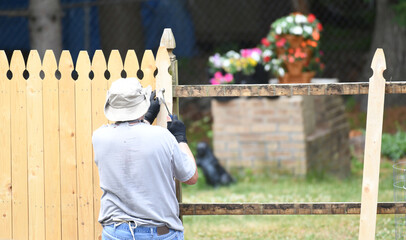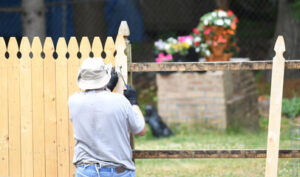Wood fences may look simple, but they have a lot of components that make them complex. If you are looking to get one, it is important that you understand how they work.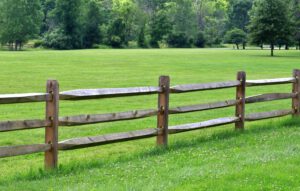
Wooden Fence NJ is made from a variety of materials, including pine and redwood. They can be customized with curves and latticework. They also have a good amount of strength and durability.
A wood fence can add beauty to a property but requires routine maintenance. These regular tasks include raking, trimming, and staining. A good stain protects the wood from moisture, insect damage, and fungus, prolonging the life of the fence. It also prevents splinters and knots and keeps the fence from fading its natural color.
Choosing the type of wooden fence depends on the style you want and your budget. You can choose from many different styles, including pickets, post-and-rail, shadow box, and lattice. However, all wood fences have the same basic components. They are constructed of posts, rails, and infill boards. Infill boards are usually made from pine, cedar, cypress, or redwood. The boards can be fastened to the rails with screws, and are often pre-stained to resist weathering and decay.
The first step in installing a wooden fence is to lay out the design. Start by establishing the property lines with your neighbors and checking your survey. Next, mark the perimeter with batter boards (temporary frames made from furring strips) and mason line. This will help you make sure the fence is up to code and that it’s a good distance from your house.
After the batter boards are in place, you can begin to install the wood fence panels. Use a level to check the slope of each row of fence. It’s important to have a consistent slope so the panels won’t sag over time. Also, use a tape measure to determine the overall square footage of your yard. This will help you get accurate prices when shopping for materials.
One of the most important aspects of maintaining a wooden fence is to keep it clear of fallen leaves and debris. These piles trap moisture and accelerate mold growth. Rake the area regularly to prevent rot. Another important aspect of maintenance is keeping the bottom of your fence free of weeds and dirt. This will prevent moisture from seeping through the weeds and into your fence.
If you are using a wooden fence that has not been treated, it is important to apply a wood preservative every two or three years. This will prevent the wood from rotting and extend its life. You can also paint your fence, but it is best to use a waterproof stain or sealant to avoid damaging the metal components of the fence.
Durability
A wood fence provides an attractive and functional barrier to protect your home or business. It can also add a rustic charm to your property. However, if not properly maintained and protected from the elements, a wooden fence will eventually degrade. Moisture and sun exposure are two of the main culprits for deterioration. Moisture leads to rot, discoloration, and insect infestation. Insects like termites can eat away at the fence, destroying its integrity. In addition, water damage can cause warping and bowing.
To keep your wooden fence from rotting, it is important to understand how it is constructed and what types of maintenance are necessary. To start, consider the type of wood you’ll use. Different species of wood have different properties that can affect the durability of your fence. For example, cedar and redwood are more resistant to rot than other species of wood. Regardless of the type of wood you choose, make sure it is pressure-treated to prevent moisture from penetrating the fence.
Another factor to consider is the local climate. If you live in a wet area, choose treated pine to prevent rot and other issues caused by moisture. Pinewood is a softwood that can be easily shaped and stained. It also resists shock better than most other woods and is a great choice for fencing.
Inspect your fence regularly for signs of rot or other damage. If you find any loose boards or sections of a sagging fence, repair them with concrete spurs. These long, thin concrete blocks can be purchased online or at most home improvement stores.
You should also apply a moisture repelling oil-based wood stain to your wooden fence. This will help prevent rot by blocking the absorption of moisture that can cause rot and discoloration. You can choose from a variety of stain colors, depending on your preferences. However, you should choose a stain that will complement the color of your wood fence. You can also opt for a clear stain, which will allow the wood’s natural grain to show through. A clear stain will also provide more protection from sun and wind than paint, which can peel and chip.
Styles
There are a number of different styles of wood fences. Some are used for practical purposes, such as providing privacy or establishing property lines, while others offer an attractive aesthetic that can enhance a home’s curb appeal. In general, wood fencing is constructed from vertical posts that are set in the ground and horizontal rails. The rails can be either pickets, fence boards, or lattice panels. They are connected to the posts by means of nailing. The rails are often treated to provide greater resistance to rot and termites.
The chief screening component of a wooden fence is the in-fill, which can consist of individual boards or prefabricated panels that integrate their own horizontal rails, simplifying construction. The in-fill is usually nailed to the rails with the help of a pneumatic nailer, which reduces labor costs. The in-fill is also treated to increase its strength and durability. In addition, it can be stained or painted to achieve a desired appearance.
A variety of woods can be used to construct a wooden fence, including redwood and cedar. Cedar is a popular choice because it resists rotting and insect infestation better than other types of wood. However, it is more expensive than other woods.
Another common type of wood is pinewood. This type of softwood is available in various shades, from a creamy white to yellowish color. It can be stained to match any color scheme. It is also relatively inexpensive and durable, though it requires periodic staining to prevent it from aging too quickly.
The maintenance required for a wood fence is considerable. This includes regular cleaning and refinishing, as well as a thorough inspection of the components for damage or rot. In addition, the fence should be checked regularly for damage during severe weather events such as high winds. This is because extreme temperature fluctuations can weaken the wood, causing it to crack and break. In most cases, this can be prevented by using a waterproof stain or sealant. This will also protect the metal components from rust and corrosion. This will significantly extend the life of your wooden fence.
Maintenance
Whether your fence is made of natural or treated wood, it’s crucial to keep it well-maintained. This will not only help prolong its life, but will also ensure that it looks beautiful year-round. The key is to maintain a regular maintenance routine, including cleaning and staining your fence.
Start by sweeping and pressure-washing your fence to remove dirt, mildew, and other debris. Using a garden hose with a high-pressure nozzle, spray the entire surface of your fence. This will remove contaminants and pollutants that can damage the wood. Once the fence is clean, apply a waterproof sealant to protect it from moisture and sunlight. It’s important to re-apply the sealant every two to three years.
You should also re-stain your fence every couple of years to protect it from the sun’s UV rays and to maintain its color. Wood that is constantly exposed to water and sunshine will fade faster and gather green stains, so it’s best to plan on re-staining it every few years.
Another important part of maintaining a wooden fence is keeping it free from moisture, which can cause rot and decay. This can be done by adjusting sprinklers so that they don’t get the fence wet, and by removing leaves and debris from the ground near your fence. You should also trim back bushes and vines that may be growing near your fence. These can rub against the wall and cause damage over time.
It’s also important to keep an eye out for signs of rot or damage, such as loose boards and rusted hardware. If these issues aren’t addressed promptly, they can lead to more serious problems down the road. In addition, it’s essential to inspect the posts regularly for rot or damage. If you notice that a post is rotting, it’s best to replace it immediately to prevent further damage.
While a new fence is expensive, keeping your property safe and beautiful is worth the investment. In addition to enhancing your home’s curb appeal, it will also increase its resale value. So if you’re considering a wood fence, be sure to choose the right one for your property and budget!

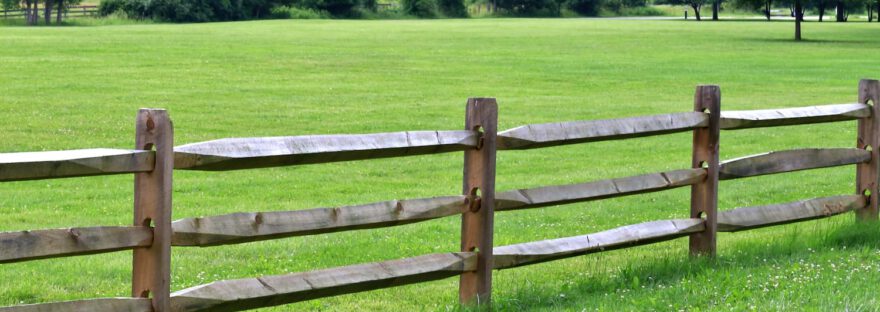

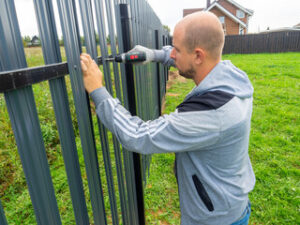 Fences are an important part of any property, providing privacy, security, and aesthetic appeal. However, like any other structure, fences can become damaged over time due to weather, wear and tear, or accidents. When a fence is damaged, it not only affects its functionality but can also detract from the overall appearance of your property. In this article, we will explore the importance of fence repair and the common types of fence damage that require repair.
Fences are an important part of any property, providing privacy, security, and aesthetic appeal. However, like any other structure, fences can become damaged over time due to weather, wear and tear, or accidents. When a fence is damaged, it not only affects its functionality but can also detract from the overall appearance of your property. In this article, we will explore the importance of fence repair and the common types of fence damage that require repair.